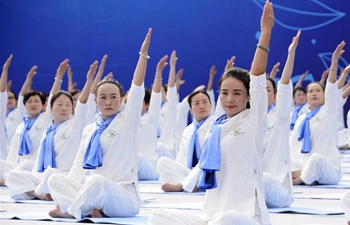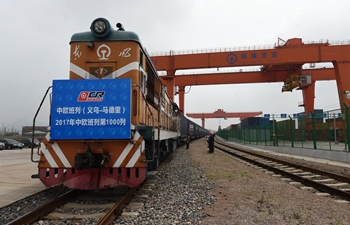
A cargo ship docks at the port of Qingdao, east China's Shandong Province, Jan. 20, 2014. (Xinhua)
BEIJING, May 17 (Xinhua) -- While the Chinese economy returned to a stabilizing trend in April after a stronger-than-expected first quarter, the traction behind its firm steps is somehow different from what it used to be.
Though the official April economic indicators were basically flat or even softened slightly from the March level, strides are being made on the restructuring side, which focuses more on consumer spending, innovation and services.
For instance, while growth in China's retail sales slowed 0.2 percentage points from the March level to 10.7 percent in April, consumption activities in rural areas expanded at a quicker pace of 12.6 percent, and online retail sales surged 32 percent.
Meanwhile, fixed asset investment in high-tech industries and the service sector jumped 22.6 percent and 12.1 percent, compared with a 8.9 percent growth in the overall fixed asset investment.
In contrast, investment in high-energy-consuming sectors was down 1.7 percent in the first four months, official data showed.
This is in line with the government move to cut excessive and outdated capacity and encourage industrial upgrading, which aims to reduce reliance on investment and exports of low value-added goods and narrowing the income gap between urban and rural dwellers.
Xing Zhihong, spokesperson for the National Bureau of Statistics, stressed the "new factors" in the recent economic trend, which range from services, business patterns and technologies.
High-tech and low-carbon products witnessed faster production growth in the first four months, with the production volumes of industrial robots and solar batteries surged 51.7 percent and 18.2 percent, respectively, Xing told a press conference.
"The booming new services, such as bike-sharing, online education and smart healthcare, have greatly enriched our social and economic lives," he said.
Chinese authorities have repeatedly emphasized the importance of shifting from traditional economic growth engines to new ones.
Chinese Premier Li Keqiang said last month that China must speed up replacing old growth drivers to transform and upgrade the economy, and that the key to the shift of growth drivers lies in technology.
In the capital market, listed companies related to the new growth engines are also taking top positions in profit rankings.
Hangzhou Hikvision Digital Technology, a leading Chinese video surveillance manufacturer, said the company's net profit is likely to surge by 15 to 35 percent in the first half of this year, ranking third place among the more than 1,100 listed companies that have so far released their half-year forecasts.
However, authorities did not shy away from the moderation in overall economic activities, terming it as "fluctuations within a reasonable and expected range."
The Chinese economy is facing "both upside momentum and downward pressure" while it goes through a crucial time of growth shift and structural improvement, said Xing, who admitted that there are still structural contradictions and overcapacity issues.
The government trimmed this year's growth goal to around 6.5 percent from a range of 6.5 to 7 percent in 2016, a move expected to provide more wiggle room for reforms.
China reported an eye-catching growth of 6.9 percent for the first quarter of 2017, but economists are expecting moderation in following quarters over concerns that China's ongoing scrutiny in the financial sector could dampen growth.
Against the backdrop of the ongoing financial regulatory tightening, investment firm China International Capital Corporation (CICC) said it sees a "soft-patch" of economic data in the next couple of months amidst reduced inflationary expectations and rising risk premium.
But the pace of the government tightening has been "more measured and better coordinated," and the Chinese economy is in a healthier position compared to past conditions, said the CICC.
The government will try to manage the magnitude of tightenings so as to balance its dual objectives of supporting growth and containing leverage and risks, said UBS China in a research note.















